These Pulitzer-Winning photos by five Associated Press photographers, depict the trauma and suffering caused by the Syrian war. Giving them their highest award helps raise public awareness of the situation.
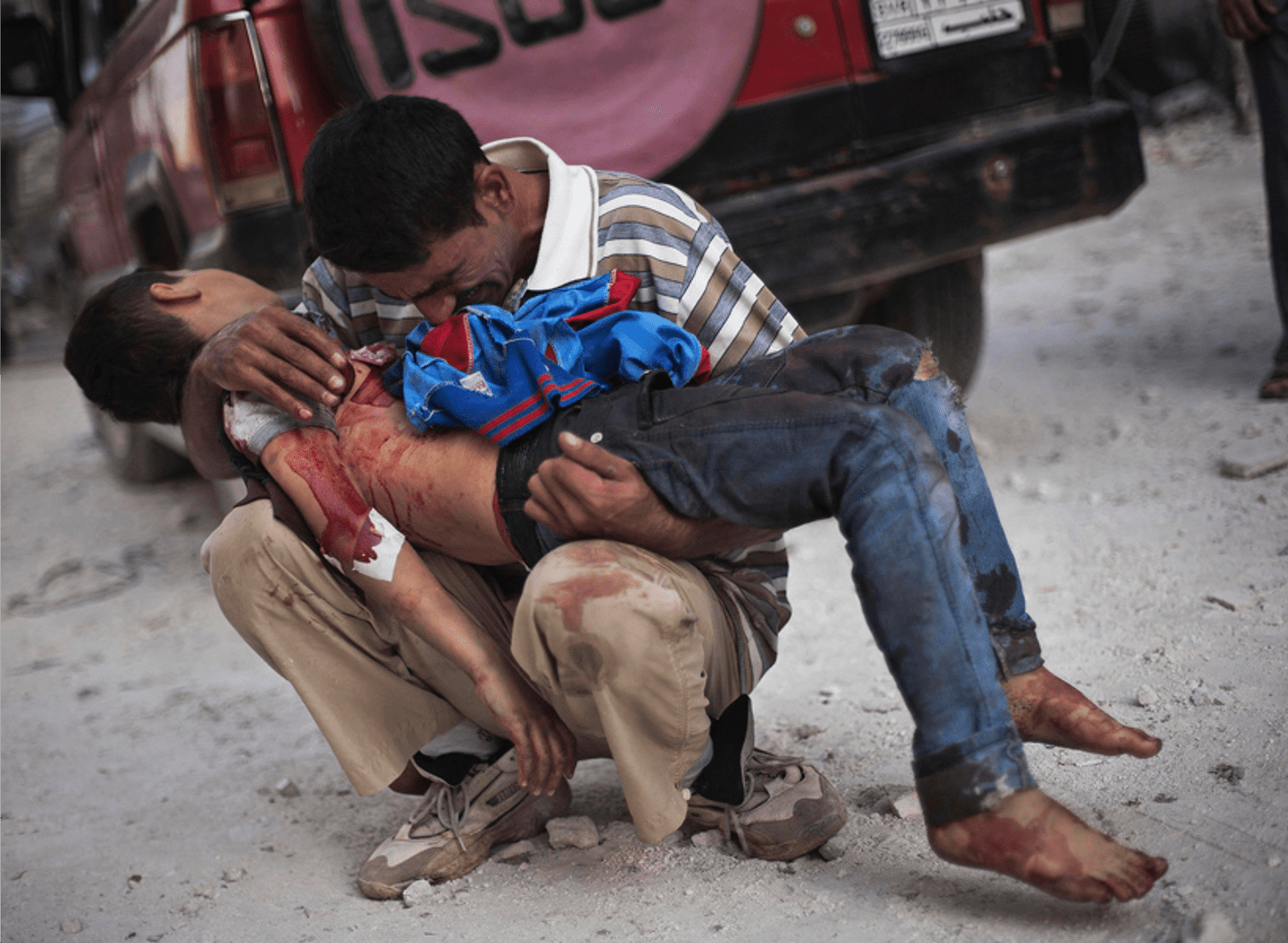
A tragic photo captured the moment a father picked up his dead son and cried over him. This photo and 19 others depict the trauma and suffering of the Syrian war. They all feature Arabic men and women with blood on their bodies or with weapons in their hands. On April 15th, 2013 Columbia University awarded the Associated Press the prestigious Pulitzer Prize in the “Breaking News” category. The photos all depicted various perspectives of the Syrian war. The photos were all taken by five different photographers.
These incredible yet tragic photographs of war-torn Syria received such high recognition. Not only because of their technical perfection but also because they showed the harsh realities of the Syrian conflict. Such graphic images can incite a wide range of emotions inside the viewers. The emotions enable them to experience the photo in a real way.
Purpose Of The Pulitzer Prize
The purpose of awarding photographers the Pulitzer is to recognize photographers who have excelled in professional photojournalism in the previous year. Interestingly, the winners for the only two photography categories were photos from the Syrian war. Another interesting thing about the award is that for “Breaking News” five photographers won. All from the Associated Press, instead of the typical one according to Fstoppers.com.
By awarding those photographers the Pulitzer, it helped bring those photos more into the public consciousness. It made it possible for more people to see their messages. The message, or story, depicted in each photo can have a profound impact on the way the viewer perceives the war as a whole.
It can be very easy for a viewer of the Pulitzer-Winning photos to simply admire the content of the image. To focus solely on the subject of the photo without giving thought to why those photos are there before them. Newspapers all over the world published these Pulitzer-Winning photos alongside articles written about the Syrian conflict. When seen within that context it gives the photo great meaning. The news articles reinforce what the photos depict. The adjoining articles further influence how people interpret those photos.
Prizing Winning Photos All Depict The Syrian War
Columbia University awarding these photos the Pulitzer brings them into another context. The university is telling the world that these photos deserve to be viewed, studied, and recognized. This recognition not only brings attention to the photographers’ skills but also the content of the images. To the violent and tragic situation in Syria. When seeing these photos within the context of award-winning instead of a news story, it completely changes their meaning. The focus shifts from the suffering seen in them to the photographer’s ability to capture that suffering.
Though each photo was taken in Syria during an uprising against the government. They all provide very different perspectives of the same conflict. The 21 photos depict people in a variety of tragic situations. The photos depict a variety of war tragedies. People with blood on their clothes. Kids holding guns and snipers aiming their guns. They depict people who have been killed or on the verge of death. This ugly and horrific war these photos captured is very controversial. Therefore, this makes the Pulitzer-winning photos themselves controversial as well. Also, the country of Syria did not want reporters there taking photographs of the conflict. They routinely picked up media people and made them leave the country.
Message Of The Photos
According to AP.org, the photographers made several trips to Syria without permission or protection from the government. Having to deal with the dangers of shelling, bombs, and flying bullets. Paul Wood at CPJ.org reported that all sides of the conflict were guilty of threatening, kidnapping, and even killing journalists. The risk involved in capturing such photos is very high. Columbia undoubtedly considered this when deciding who to award the Pulitzer Prize.
The message all the photos appear to be clearly stating is that war is ugly. That war causes so much suffering and pain, emotional and physical. One of the photos depicts an adolescent boy named Ahmed crying at his father’s funeral by Rodrigo Abd shows how the death toll from the war is devastating families. A closer look at this photo reveals the tears streaming down his cheek as an older man lays his hand on his head. This photo along with all others brings a lot of attention to the tragedy of the Syrian conflict.
Syrian War Background
The war in Syria initially started as protests in March of 2011, against President Bashar Al-Assad’s regime. The internal Red Cross declared what was happening a civil war. CBCNews reported that hundreds of thousands of people were fleeing the country and the death toll climbed higher than 100,000 people. The international community grew alarmed at the situation. This war is a natural consequence of a group of people deciding to rise up against their government to pursue their own interests.
Gordon Marshall’s Conflict Theory states that the pursuit of interests creates a variety of types of conflicts which are normal aspects of social life and not abnormal or dysfunctional. New agencies wanted to report on the civil war. So photographers began risking their lives by going to a country that is very hostile towards media personal to document the violence happening there. The images coming from Syria were shocking and tragic to Americans. People began to immediately choose sides and the photos had a huge impact on that reaction.
Depicting The Nature Of Human Conflict
Upon close inspection, each photo reveals intimate and intriguing details about the war in Syria. They also reveal details but about human conflict in general. People all over the world experience extreme tragedy and suffering in their lives. To capture such moments vividly in a photograph is an incredible feat. Perhaps that was the aim of the Pulitzer Prize this year. To bring attention to human suffering that is happening around the world.
An analysis of five of the 20 Pulitzer-Winning photos by the five Associated Press photographers awarded in the “Breaking News” category and the one photo awarded in the “Featured Photography” category will reveal a lot about the message of images. Each of the awarded photographs was very carefully composed by the photographer to further enhance the story of the photo. When considering the photographer’s composition, exposure, angle, and technique. The message of the photos are less about what the subject and than about what the photographer is trying to say.
The photographer’s perspective of the civil war could have a huge impact on how the viewers of the images. And how they will view the war. Also, because photos in journalism are metonyms. This means they are small representations of the whole, they never truly give the whole picture as Dr. David Perlmutter in his article Wisdom: We can teach from images of war.
The Pulitzer-Winning photos:
Manu Barbo’s Photo
In the “Breaking News” category, one of winners was Manu Barbo’s “A Syrian man cries while holding the body of his son near Dar El Shifa hospital in Aleppo, Syria, Oct. 3, 2012. The boy was killed by the Syrian army.”
The photo above in this article, was taken at eye level and close to the ground by the father. At TheNationNews.com Manu Barbo was asked about the way he gets close to his subjects. He replied: “I’m close because I try to coexist as much as possible with the people I photograph – to be inside the story, to live it, enjoy it, or suffer it.” At this angle, it is easy to see the boy’s bloodied body and the face of the grieving father. His loss becomes shared with the viewer, even if on a superficial level. The conflict quickly appears closer to home because of how it invokes the pain associated with losing a child. This type of imagery is very convincing about how evil the other side is.
Javier Manzano’s Photo
Javier Manzano won the award in the “Featured Photography” category. His photo is titled “two Syrian rebel soldiers tensely guarding their position as beams of light stream through bullet holes in a nearby metal wall. Mexican free-lance photographer Manzano took this photo in Karmel Jabl. The photo depicts two Syrian Free Army snipers inside of a dark room with beams of light shining through holes made from bullets and shrapnel.
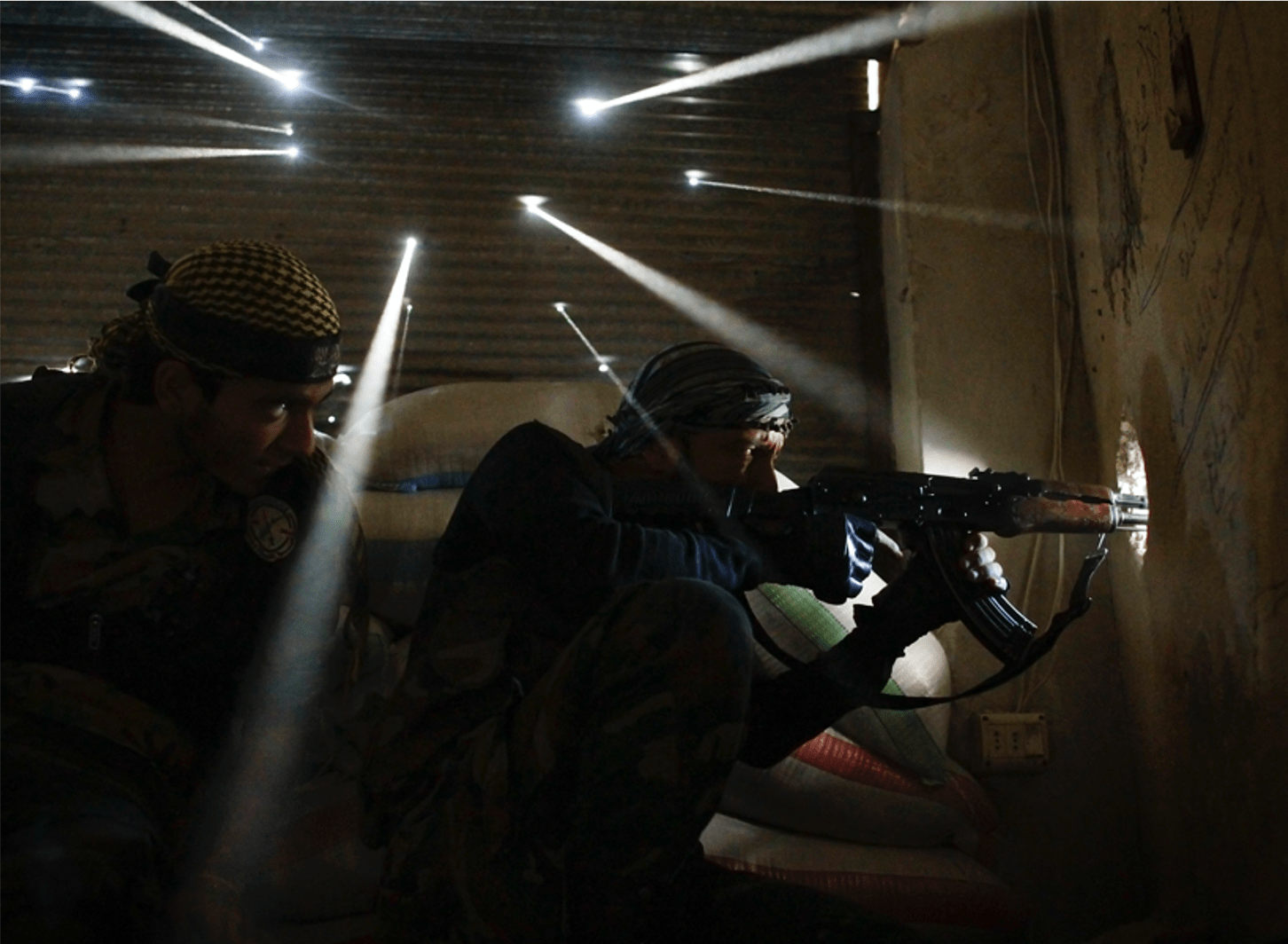
The intenseness of the war can be clearly seen in this photo. The bullet holes in the wall are evidence of the fighting and warring that is happening outside of this building. Small amounts of light illuminate their eyeballs as they gaze through the hole watching for the enemy. Syria’s civil war is characterized by a lot of sniper-type attacks. That reality is depicted well in this photo. It shows how the war appeared from the perspective of the Free Syria Army. The Free Syria Army is the force rebelling against the government there.
Photographer used an eye-level angle to capture the snipers. Therefore the snipers’ perspective is seen and the viewer can feel like they are squatting down with them. It creates a very personable and close experience for viewers. With the photo taken at eye level and very close to the faces it is easy to sympathize with the snipers. This happens because the viewer is on the ground with them. This sympathy can be used by the media to gain support for the Free Syria Army if it so chose to do so.
Rodrigo Abd’s Photo
Another on of the Pulitzer-Winning photos from the “Breaking News” category on Pulitzer.org captured by AP photographer Rodrigo Abd is described as “A man teaches Bilal, 11, how to use a toy rocket-propelled grenade in Idlib, northern Syria, March 4, 2012.”
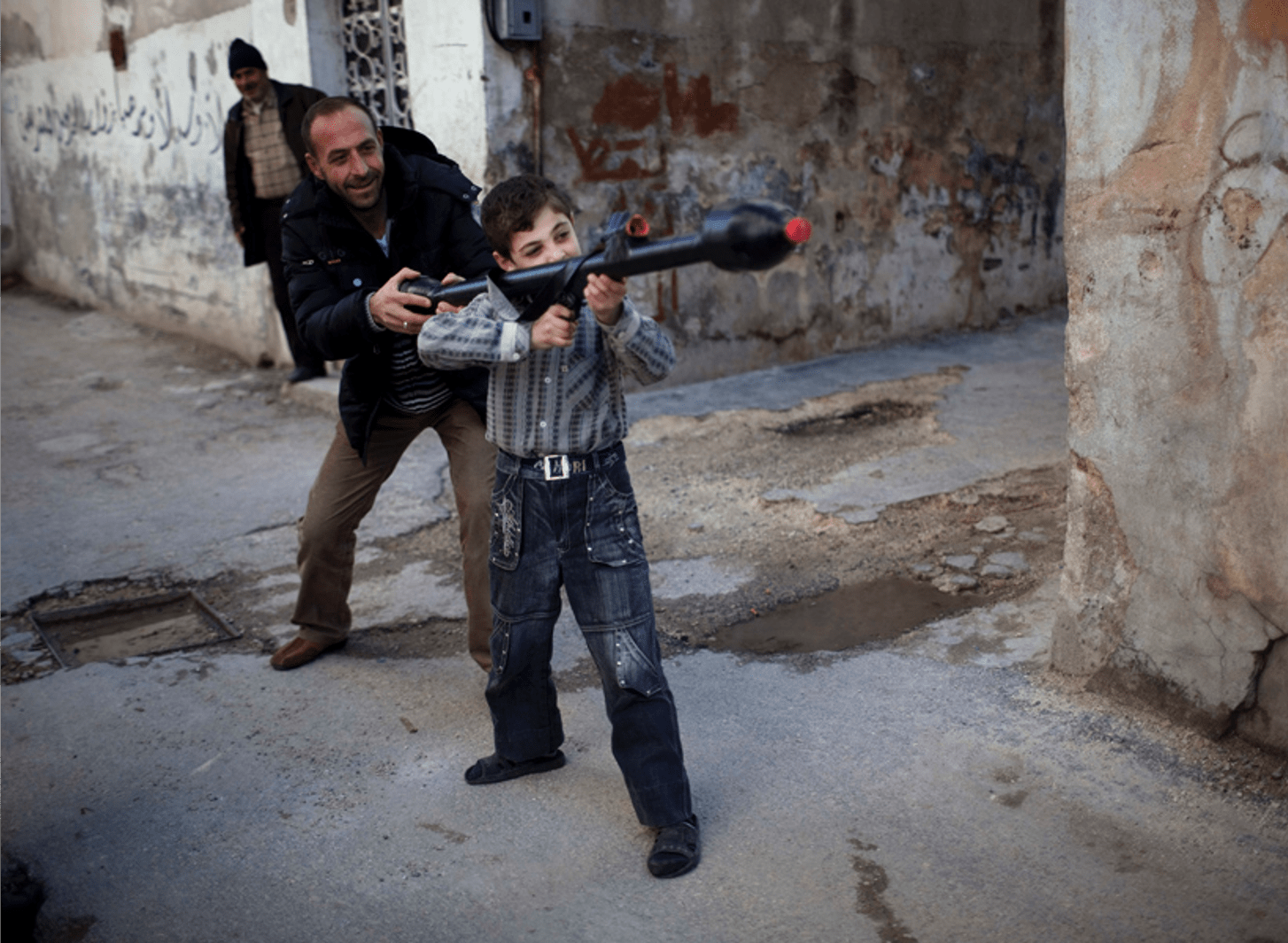
This photo gives a very different perspective of the war compared to other photos. Instead of showing violence, it shows a father with his son, teaching him violence. It is a tragic image. We can see that the father is teaching him how to kill instead of merely having fun with his son. The smile on the father’s face makes it look as if she is proud of his son. The stance of the boy makes him appear proud and strong, ready to fight and kill. This behind-the-scenes image allows the viewer to see how people are responding to the war when not in combat. The kind of tragedy seen in this photo is different from the others. The boy appears to be preparing to fight instead of playing with a toy.
Khalil Hamra’s Photo
Another photo from the Breaking News” category is “Free Syrian Army fighters sit in a house on the outskirts of Aleppo, Syria, June 12, 2012.” by Khalil Hamra.
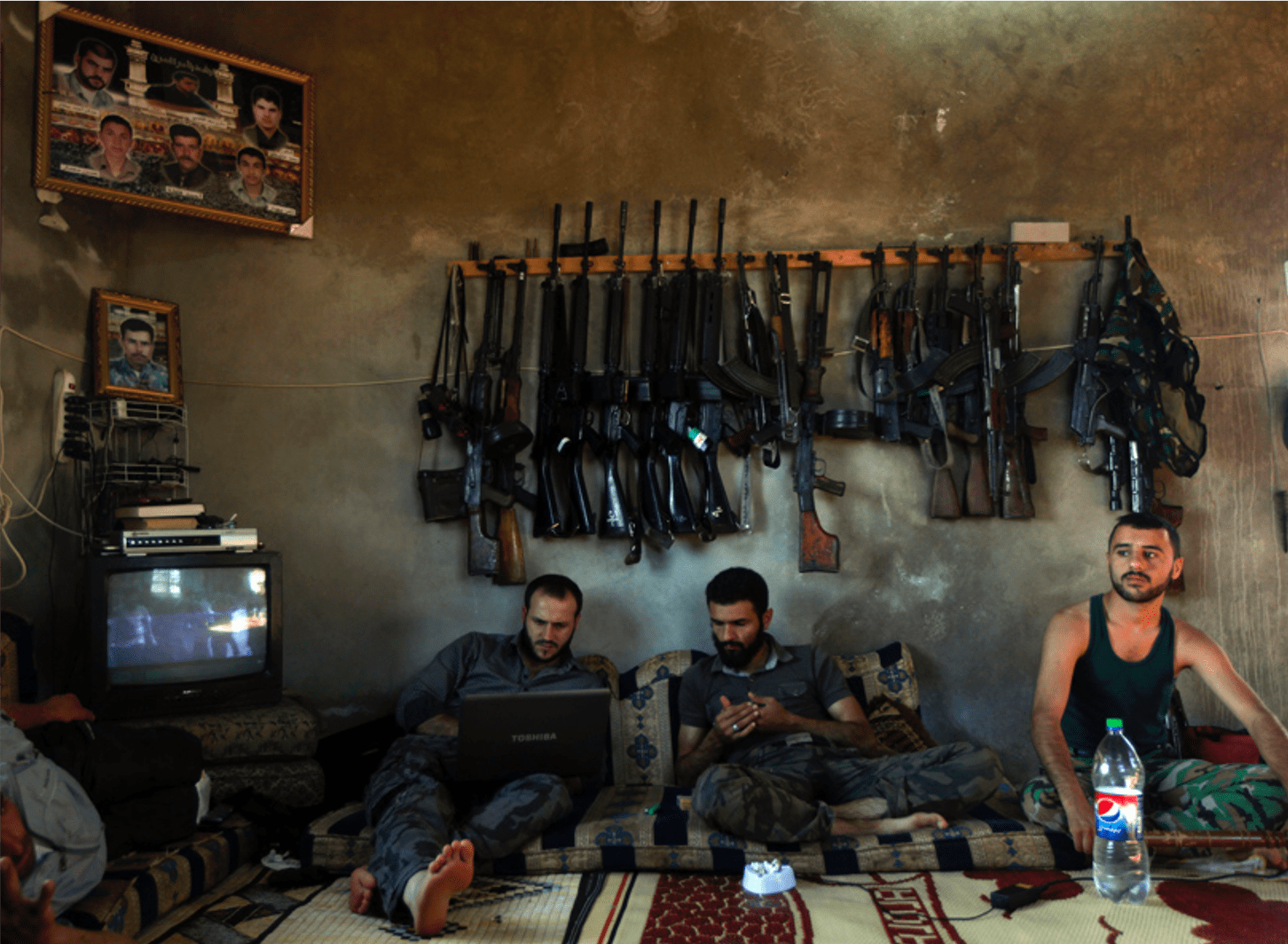
The focus of this perfectly composed photo is to show the Free Syria Army soldiers in their downtime. Again, this photo is down at eye level to reinforce that personal level. Also, the way the soldiers are lounging around, looking at a computer, smoking a cigarette, and the tv is on with an empty Pepsi bottle makes it almost feel like home. The guns on the wall and the military uniforms immediately remove that familiarity. Within this photo, major conflicts are happening between familiarity and foreign, safety and at war, resting and fighting. Those conflicts happening within the photo help the viewer identify with the conflict happening within the lives of those men.
Narciso Contreras’s Photo
Narciso Contreras’ photo, “A wounded Syrian civilian lies in the street with a shot to his stomach as he tries to escape the line of fire after he was targeted by a Syrian army sniper while walking near the frontline in the Bustan al-Qasr neighborhood of Aleppo, Syria, Oct. 20, 2012.” was also in the group of winners.
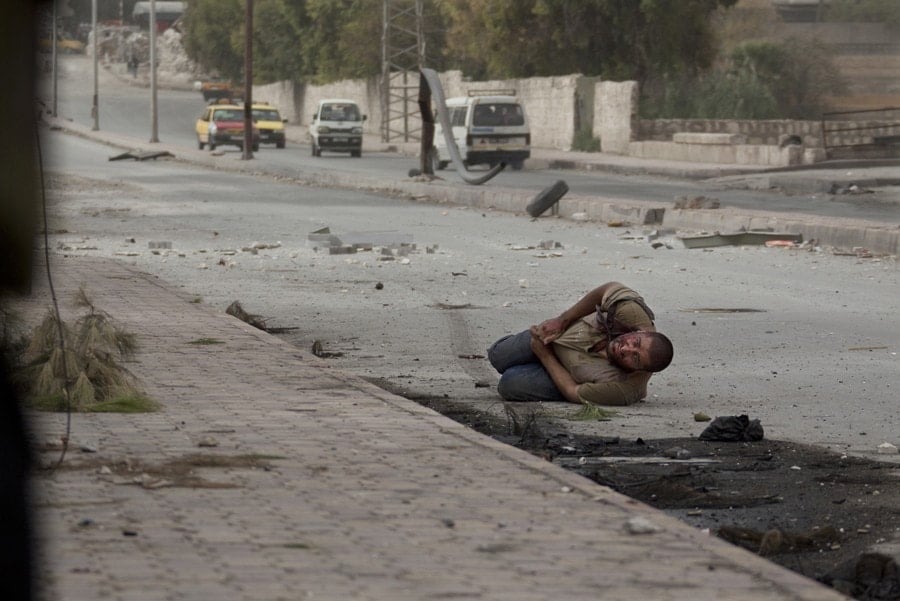
Narciso Contreras said in an interview with The Guardian, “my time is spent photographing the situation faced by civilians in Aleppo, how they cope with hardly anything, and how they deal with their tragedy” (Powell, 2012). He chose to focus his photography on the plight of the civilians.
Many of his Pulitzer-Winning photos focus on how the conflict impacts those not directly involved. His photo shows a wounded man laying on a street full of debris. The emptiness of the streets adds an eerie feel to the photo. It shows the fear people are living in. The emptiness captured in the background of the wounded man represents the fear the civilians are living in Syria. By using such empty space, the photographer helped people feel the fear that not just what man must be feeling, but what everyone there is feeling.
Muhammed Muheisen’s Photo
Lastly, is the only photo in the “Breaking News” category by Muhammed Muheisen. The photo called “Abdullah Ahmed, 10, who suffered burns in a Syrian government airstrike and fled his home with his family, stands outside their tent at a camp for displaced Syrians in the village of Atmeh, Syria, Dec. 11.” This photo of a young boy wrapped in bandages all over his body in a refugee camp shows the plight of those fleeing Syria to avoid the war.
The photography very effectively used the background to frame the boy that helps tell his story. The tents set up on undeveloped land with families walking around tell the viewer where he is and that his story is part of a larger one. Also, the angle further reinforces his situation. Since the angle is not at eye level. Instead, it’s from the perspective that an adult would be looking at him reminds the adult viewer that he is a child. That he is a child, a helpless child that has suffered greatly from the devastation of war.

The Syrian Conflict Photos Influence On The Viewer
These interesting and tragic Pulitzer-Winning photos of the Syrian conflict along with 15 other photos. They all depict the war from very emotional perspectives. All the photos appear to be biased against the war. This would seem to be a natural bias, mainly because of all the suffering that results from it. The Free Syria Army is the one who started the war by rising up against the government of Syria. Assad’s regime responded with great force. That conflict is what is causing so much pain to the people who are near it.
By the photographers risking their lives and taking those Pulitzer-Winning photos, the war became more real than a newspaper headline. When Columbia University awarded them the Pulitzer Prize, that recognition told the public that those photos deserve attention. This in turn brought more attention to the civil war. It would appear that the Pulitzer selection board preferred photos that depicted conflict within a conflict. This recognition acknowledges the suffering that people are experiencing in Syria.